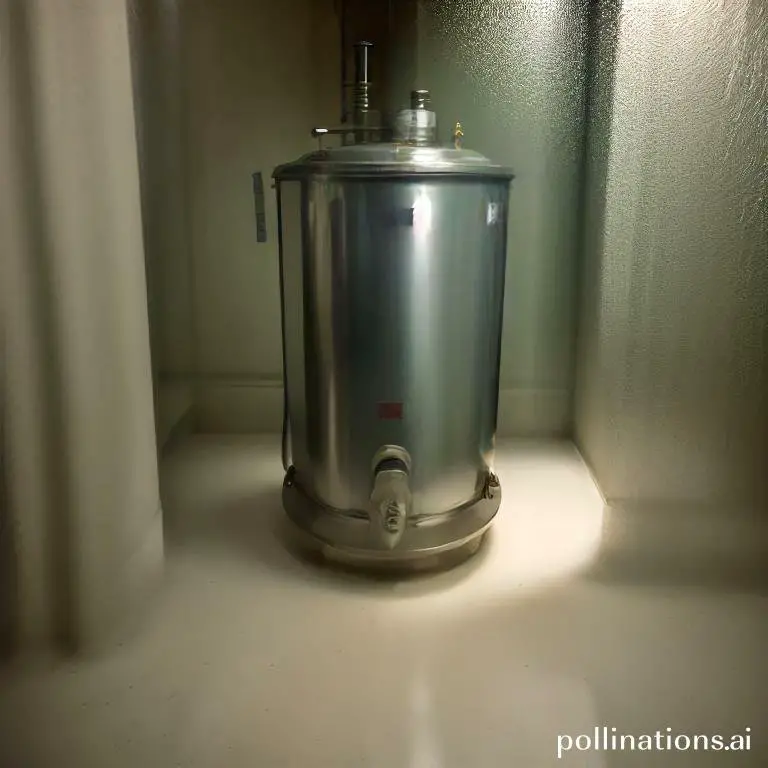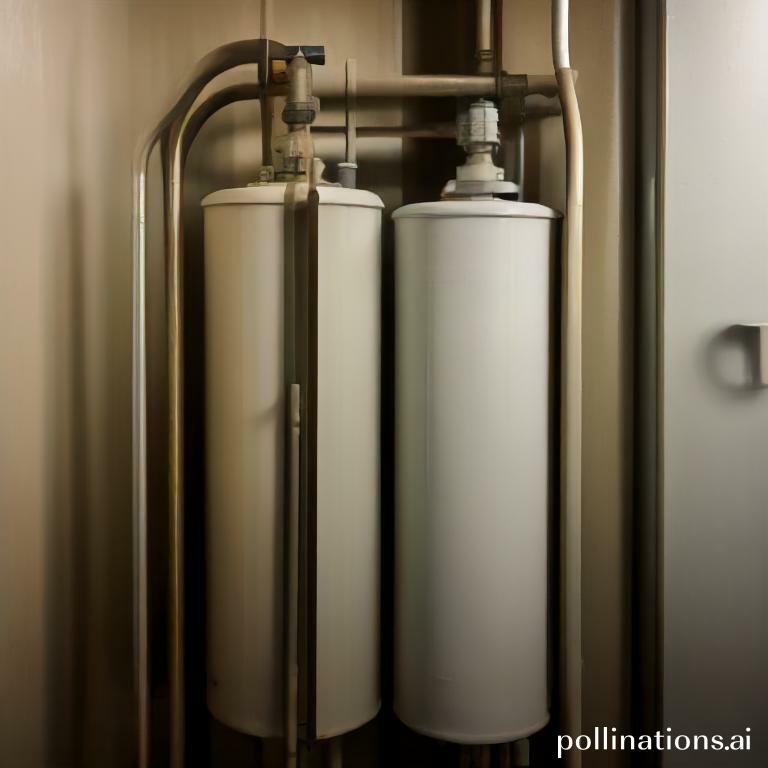
II. One important aspect of water heater maintenance is removing sediment from the tank. This involves draining the tank and flushing out any buildup that has accumulated over time.
III. Another important maintenance task is checking and, if necessary, replacing the water heater’s expansion tank. This component helps regulate pressure in the system and can prevent damage to the tank or other components.
In order to maintain a properly functioning water heater, pivotal to regularly remove sediment and maintain the expansion tank. Sediment can build up over time and affect the efficiency of the heater, resulting in higher energy bills and reduced performance.
By regularly removing sediment, you can ensure that your water heater operates at its optimal level. Additionally, maintaining the expansion tank helps to regulate pressure within the system and prevent potential damage.
By taking these simple steps, you can extend the lifespan of your water heater and enjoy consistent hot water supply.
Sediment Removal: How to Keep Your Water Heater Running Smoothly
1. What is Sediment Buildup and How Does it Affect Your Water Heater?
Sediment buildup refers to the accumulation of minerals and debris, such as calcium, magnesium, and rust, in your water heater tank over time. This accumulation can have several negative effects on your water heater’s performance and efficiency. To begin with, sediment can act as an insulating layer, reducing the efficiency of heat transfer and leading to increased energy consumption. Additionally, sediment can settle at the bottom of the tank, causing corrosion and potentially damaging the tank itself. Finally, sediment buildup can also clog the water lines, resulting in reduced water flow and pressure.
2. How to Identify Sediment Buildup in Your Water Heater
There are several signs that indicate the presence of sediment buildup in your water heater. These include a decrease in hot water supply, unusual noises coming from the tank, a foul odor or taste in the hot water, and visible particles in the water. If you notice any of these signs, it is likely that sediment has accumulated in your water heater and needs to be removed.
3. Steps for Safe and Effective Sediment Removal
To ensure safe and effective sediment removal from your water heater, follow these steps:
- Turn off the power supply to the water heater.
- Allow the water heater to cool down for a few hours.
- Locate the drain valve at the bottom of the tank and attach a hose.
- Place the other end of the hose in a suitable drainage area.
- Open the drain valve and allow the water to flow out, flushing out the sediment.
- Close the drain valve and remove the hose.
- Turn on the water supply and fill the tank back up.
- Turn on the power supply to the water heater.
4. Recommended Frequency for Sediment Removal
The frequency of sediment removal depends on the hardness of your water and the usage of your water heater. As a general guideline, it is recommended to flush out the sediment from your water heater once a year. That being said, if you notice any of the signs mentioned earlier or if you have exceptionally hard water, more frequent sediment removal may be necessary.
| Benefits of Sediment Removal | Consequences of Ignoring Sediment Buildup |
|---|---|
| 1. Improved Efficiency: Removing sediment allows for better heat transfer, resulting in a more efficient water heater. | 1. Decreased Efficiency: Sediment acts as an insulator, reducing heat transfer and increasing energy consumption. |
| 2. Extended Lifespan: Regular sediment removal can prolong the lifespan of your water heater by preventing corrosion and damage. | 2. Tank Damage: Sediment buildup can cause corrosion and damage to the water heater tank, leading to leaks and costly repairs. |
| 3. Better Water Flow: Removing sediment improves water flow and pressure, ensuring a steady supply of hot water. | 3. Reduced Water Flow: Sediment can clog the water lines, resulting in reduced water flow and pressure. |
Water Heater Expansion Tank Maintenance. Keeping Your System Safe and Efficient
1. What is an Expansion Tank and Why is it Important?
An expansion tank is a crucial component of a water heater system. It is responsible for accommodating the increased volume of water that occurs during the heating process. Without an expansion tank, the pressure within the system can rise to dangerous levels, leading to potential damage or even a catastrophic failure.
2. Signs of a Failing Expansion Tank
It is essential to be aware of the signs that indicate a failing expansion tank. The most common indicator is excessive water leakage from the tank. This can be observed around the connections or through the pressure relief valve. Additionally, if you notice fluctuating water pressure, strange noises coming from the tank, or a decrease in hot water supply, it may be a sign that your expansion tank needs attention.
3. Steps for Maintaining Your Expansion Tank
Maintaining your expansion tank is relatively straightforward and can significantly extend its lifespan. Start by shutting off the power supply to the water heater and closing the water supply valve. Next, drain the tank by attaching a hose to the drain valve and opening it fully. Once the tank is empty, check the air pressure using a tire pressure gauge and ensure it matches the manufacturer’s recommended pressure. If it is too low, use a bicycle pump to add air until the desired pressure is reached. Finally, inspect the tank for any visible signs of damage or corrosion and address them accordingly.
4. Recommended Frequency for Expansion Tank Maintenance
To ensure the optimal performance of your expansion tank and water heater system, regular maintenance is essential. It is recommended to inspect and maintain the expansion tank at least once a year. Although, if you live in an area with hard water or experience frequent temperature changes, more frequent maintenance may be necessary. Regular maintenance will help prevent costly repairs and ensure the safety and efficiency of your water heater system.
DIY vs Professional Maintenance. Which is Right for You?
1. Pros and Cons of DIY Maintenance
- Pros: DIY maintenance allows you to save money as you won’t have to hire professionals. It also gives you a sense of accomplishment and self-reliance.
- Cons: Nevertheless, DIY maintenance requires time, effort, and knowledge. If not done correctly, it can lead to further damage or even safety hazards.
2. Pros and Cons of Professional Maintenance
- Pros: Professional maintenance ensures expertise and experience. They have the necessary tools and skills to handle any issue efficiently. It saves you time and gives you peace of mind.
- Cons: The cost of professional maintenance can be higher compared to DIY. You might also need to schedule appointments and work around their availability.
3. Factors to Consider When Choosing Between DIY and Professional Maintenance
When deciding between DIY and professional maintenance, consider the following:
- Time and Availability: Do you have the time and availability to perform maintenance tasks yourself?
- Skills and Knowledge: Do you possess the necessary skills and knowledge to handle the maintenance effectively?
- Cost: Compare the cost of DIY maintenance tools and materials versus the cost of professional services.
- Complexity: Evaluate the complexity of the maintenance task. Some tasks may require specialized expertise.
- Risk: Assess the potential risks involved. Certain tasks, such as electrical or plumbing work, may be better left to professionals.

Common Mistakes to Avoid When Maintaining Your Water Heater
1. Using the Wrong Tools or Techniques
In regard to maintaining your water heater, imperative to use the right tools and techniques. Using improper tools or techniques can lead to damage or ineffective maintenance. Make sure to research and use the appropriate tools for your specific water heater model.
2. Neglecting to Turn Off the Power
Before performing any maintenance on your water heater, always remember to turn off the power. This is a crucial step to ensure your safety and prevent any accidents. Turning off the power will protect you from electric shocks and other potential hazards.
3. Failing to Drain the Tank Completely
Regularly draining your water heater tank is essential for its proper functioning. Failing to drain the tank completely can result in sediment buildup, reduced efficiency, and even damage to the tank. Follow the manufacturer’s instructions to effectively drain the tank and remove any accumulated sediment.
4. Overlooking the Expansion Tank
The expansion tank is an important component of your water heater system. It helps regulate the pressure inside the tank and prevent potential damage. Many homeowners overlook the expansion tank during maintenance, but it is crucial to check its functionality and ensure it is properly installed.
5. Skipping Regular Maintenance
One of the most common mistakes homeowners make is neglecting regular maintenance of their water heater. Regular maintenance is essential to keep your water heater running efficiently and extend its lifespan. Don’t skip routine maintenance tasks such as checking the pressure relief valve, inspecting the anode rod, and flushing the tank.
| Mistake | Consequence |
|---|---|
| Using the Wrong Tools or Techniques | Potential damage or ineffective maintenance |
| Neglecting to Turn Off the Power | Risk of electric shocks and accidents |
| Failing to Drain the Tank Completely | Sediment buildup, reduced efficiency, and tank damage |
| Overlooking the Expansion Tank | Potential pressure-related damage |
| Skipping Regular Maintenance | Reduced efficiency and shortened lifespan |

Tips for Extending the Life of Your Water Heater
Water heaters are essential appliances that provide hot water for various purposes in our daily lives. To ensure the longevity and efficiency of your water heater, it is crucial to follow these tips:
1. Adjusting the Temperature
One way to extend the life of your water heater is by adjusting the temperature settings. By setting the temperature to an optimal level, you can prevent excessive strain on the unit and reduce energy consumption. Consult the manufacturer’s guidelines or a professional plumber to determine the ideal temperature for your specific water heater model.
2. Flushing the Tank Regularly
Over time, sediment and mineral buildup can accumulate at the bottom of the water heater tank. This can lead to decreased efficiency and potential damage to the unit. Flushing the tank regularly helps remove these deposits and ensures smooth operation. Follow the manufacturer’s instructions or seek the assistance of a professional plumber to perform this maintenance task.
3. Installing a Water Softener
If your area has hard water, installing a water softener can significantly extend the life of your water heater. Hard water contains high levels of minerals, such as calcium and magnesium, which can cause mineral buildup and corrosion in the tank. A water softener will remove these minerals, protecting your water heater and improving its efficiency.
4. Checking Anode Rods
Anode rods are sacrificial rods that help prevent corrosion inside the water heater. Over time, these rods can become depleted and ineffective, leaving your water heater vulnerable to rust and damage. Regularly inspecting and replacing anode rods as needed can greatly extend the lifespan of your water heater.
5. Replacing Old or Inefficient Water Heaters
If your water heater is old or inefficient, it may be time to consider a replacement. Newer models are more energy-efficient and have advanced features that can enrich performance and longevity. Consult with a professional plumber to determine the best replacement option for your specific needs.
| Tip | Benefits |
|---|---|
| Adjusting the Temperature | Prevents strain on the unit and reduces energy consumption |
| Flushing the Tank Regularly | Removes sediment and mineral buildup, improves efficiency |
| Installing a Water Softener | Protects against mineral buildup and corrosion |
| Checking Anode Rods | Prevents rust and damage, extends lifespan |
| Replacing Old or Inefficient Water Heaters | Improves energy efficiency, enhances performance |
Bottom Line
Regular maintenance of your water heater expansion tank and sediment removal from your plumbing system can save you from costly repairs and replacements in the long run. Sediment buildup can cause damage to your pipes, decrease water pressure, and reduce the efficiency of your water heater. Flushing your system annually and installing a sediment filter can prevent these issues. Additionally, checking and maintaining your expansion tank can prevent leaks and extend the lifespan of your water heater. Don’t neglect these important tasks and risk expensive repairs or replacements. Take the necessary steps to maintain your plumbing system and water heater to ensure they continue to function properly for years to come.
Read More:
1. Sediment Removal For Heat Pump Water Heaters
2. Sediment Impact On Water Heater Recovery Time










